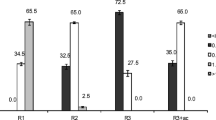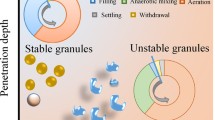Summary
The development of granular sludge in laboratory-scale upflow anaerobic sludge-blanket reactors was studied. Acetate was supplied as sole carbon source in order to select the acetotrophs Methanosarcina and Methanothrix. These microorganisms are dominant in methanogenic ecosystems and their ratio seems to control the speed of granulation. Changing the ratio of the above species was followed on the basis of their different F 420-coenzyme content. Five reactors were operated at the same hydraulic retention time but at different feed substrate concentrations. We found that granulation takes place only in acetate-fed systems but this process was slower and the resultant granules looser and less stable than those developed on sugar-starch substrate. In the range of feed acetate levels examined (0.5−0.3 g/1) higher concentrations of feed caused faster granulation of the sludge bed and, presumably, of the microbial population, and resulted in larger granules containing sludge that settled more readily. We found no evidence for selection pressure at substrate concentrations below 0.5 g/1 acetate in the reactor.
Similar content being viewed by others

References
Adebovale O, Kiff R (1988) Operational trends in UASB reactor bed stability and during initiation of granulation. In: Tilche A, Rozzi A (eds) Poster papers of the 5th International Symposium on Anaerobic Digestion. Monduzzi Editore, Bologna, p 99–103
Andrews JF (1969) Dynamic model of the anaerobic digestion process. J Sanit Eng Div Proc Am Soc Civ Eng 95:95–116
American Public Health Association (1980) Standard methods for the examination of water and wastewater, 15th edn. APHA, Washington, DC
Beelen P van, Dijkstra AC, Vogels GD (1983) Quantitation of coenzyme F 420 in methanogenic sludge by the use of reversed-phase high-performance liquid chromatography and a fluorescence detector. Eur J Appl Microbiol Biotechnol 18:67–69
Bolle WL, Breugel J van, Eybergen GC van, Kossen NWF, Gils W van (1986) Kinetics of anaerobic purification of industrial wastewater. Biotechnol Bioeng 28:542–548
Delafontaine MJ, Naveau HP, Nyns EJ (1979) Fluorimetric monitoring of methanogenesis in anaerobic digesters. Biotechnol Lett 1:71–73
Doddema HJ, Vogels GD (1978) Improved identification of methanogenic bacteria by fluorescence microscopy. Appl Environ Microbiol 36:752–754
Dohányos M, Grau P, Sedlácek M (1988) Interpretation of dewaterability measurements by capillary suction time (CST). Water Sci Technol 20:265–267
Dolfing J, Mulder J-W (1985) Comparison of methane production rate and coenzyme F 420 content of methanogenic consortia in anaerobic granular sludge. Appl Environ Microbiol 49:1142–1145
Eirich LD, Vogels GD, Wolfe RS (1978) Proposed structure for coenzyme F 420 from Methanobacterium. Biochemistry 17:4583–4593
Gorris LGM, Drift C van der (1986) Methanogenic cofactors in pure cultures of methanogens in relation to substrate utilisation. In: Dubourguier HC, Albagnac G, Montreuil, J, Romond C, Sautière P, Guillaume J (eds) Biology of anaerobic bacteria. Elsivier, Amsterdam, pp 144–150
Harada H, Endo G, Tohya Y, Mononoi K (1988) High rate performance and its related characteristics of granulated sludges in UASB reactors reacting various waste waters In: Tilche A, Rozzi A (eds) Poster papers of the 5th International Symposium on Anaerobic Digestion. Monduzzi Editore, Bologna, pp 1111–1119
Heine-Dobbernack E, Schoberth SM, Sahm H (1988) Relationship of intracellular coenzyme F 420 content to growth and metabolic activity of Methanobacterium bryantii and Methanosarcina barkeri. Appl Environ Microbiol 54:454–459
Hulshoff Pol LW, Zeeuw WJ de, Velzeboer CTM, Lettinga G (1983) Granulation in UASB-reactors. Water Sci Technol 15:291–304
Huser BA, Wuhrmann K, Zehnder JB (1982) Methanothrix soehngenii gen. nov. sp. nov., a new acetotrophic non-hydrogen-oxidizing methane bacterium. Arch Microbiol 132:1–9
Lettinga G, Velsen AFM van, Hobma SW, Zeeuw W de, Klapwijk A (1980) Use of the upflow sludge blanket (USB) reactor concept for biological wastewater treatment, especially for anaerobic treatment. Biotechnol Bioeng 22:699–734
Mahoney EM, Varangu LK, Cairns WL, Kosaric N, Muray RGE (1987) The effect of calcium on microbial aggregation during UASB reactor start-up. Water Sci Technol 19:249–260
Mink RW, Dugan PR (1977) Tentative identification of methanogenic bacteria by fluorescence microscopy. Appl Environ Microbiol 33:713–717
Reynolds PJ, Colleran E (1987) Evaluation and improvement of methods for coenzyme F 420 analysis in anaerobic sludges. J Microbiol Methods 7:115–130
Taya M, Aoki N, Kobayashi T (1986) Kinetic evaluation and monitoring of methanogen culture based upon fluorometry. Appl Microbiol Biotechnol 23:342–347
Tilche A, Yang X (1988) Light and scanning electron microscope observations on the granular biomass of experimental SBAF and HABR reactors. In: Lettinga G, Zehnder AJB, Grotenhuis JTC, Hulshoff Pol LW (eds) Granular anaerobic sludge; microbiology an technology. Pudoc, Wageningen pp 170–178
Wiegant WM (1988) The “spaghetti theory” on anaerobic granular sludge formation, or the inevitatability of granulation. In: Lettinga G, Zehnder AJB, Grotenhuis JTC, Hulshoff Pol LW (eds) Granular anaerobic sludge; microbiology and technology. Pudoc, Wageningen, pp 146–152
Wiegant WM, Man AWA (1986) Granulation of biomass in thermophilic upflow anaerobic sludge blanket reactors treating acidified wastewaters. Biotechnol Bioeng 28:718–727
Wei-min W, Ji-cui H, Xia-sheng G (1985) Properties of granular sludge in upflow anaerobic sludge blanket (UASB) reactor and its formation. In: China State Biogas Association (ed) Proceedings of the 4th International Symposium on Anaerobic Digestion. Guangzhou, China pp 339–351
Xiao-sha L, Kun-min Z, Tao PK (1985) A kinetic model of methanogenesis degradating acetate under NaCl inhibition. In: China State Biogas Association (ed) Proceedings of the 4th International Symposium on Anaerobic Digestion. Guangzhou, China pp 551
Zeeuw W de (1988) Granular sludge in UASB reactors. In: Lettinga G, Zehnder AJB, Grotenhuis JTC, Hulshoff Pol LW (eds) Granular anaerobic sludge; microbiology and technology. Pudoc, Wageningen, pp 132–145
Zehnder AJB, Huser BA, Brock TD, Wuhrmann K (1980) Characterisation of an acetate decarboxylating non-hydrogen-oxidising methane bacterium. Arch Microbiol 124:1–11
Author information
Authors and Affiliations
Additional information
Offprint requests to: J. Holló
Rights and permissions
About this article
Cite this article
Morvai, L., Miháltz, P., Czakó, L. et al. The influence of organic load on granular sludge development in an acetate-fed system. Appl Microbiol Biotechnol 33, 463–468 (1990). https://doi.org/10.1007/BF00176667
Received:
Accepted:
Issue Date:
DOI: https://doi.org/10.1007/BF00176667



